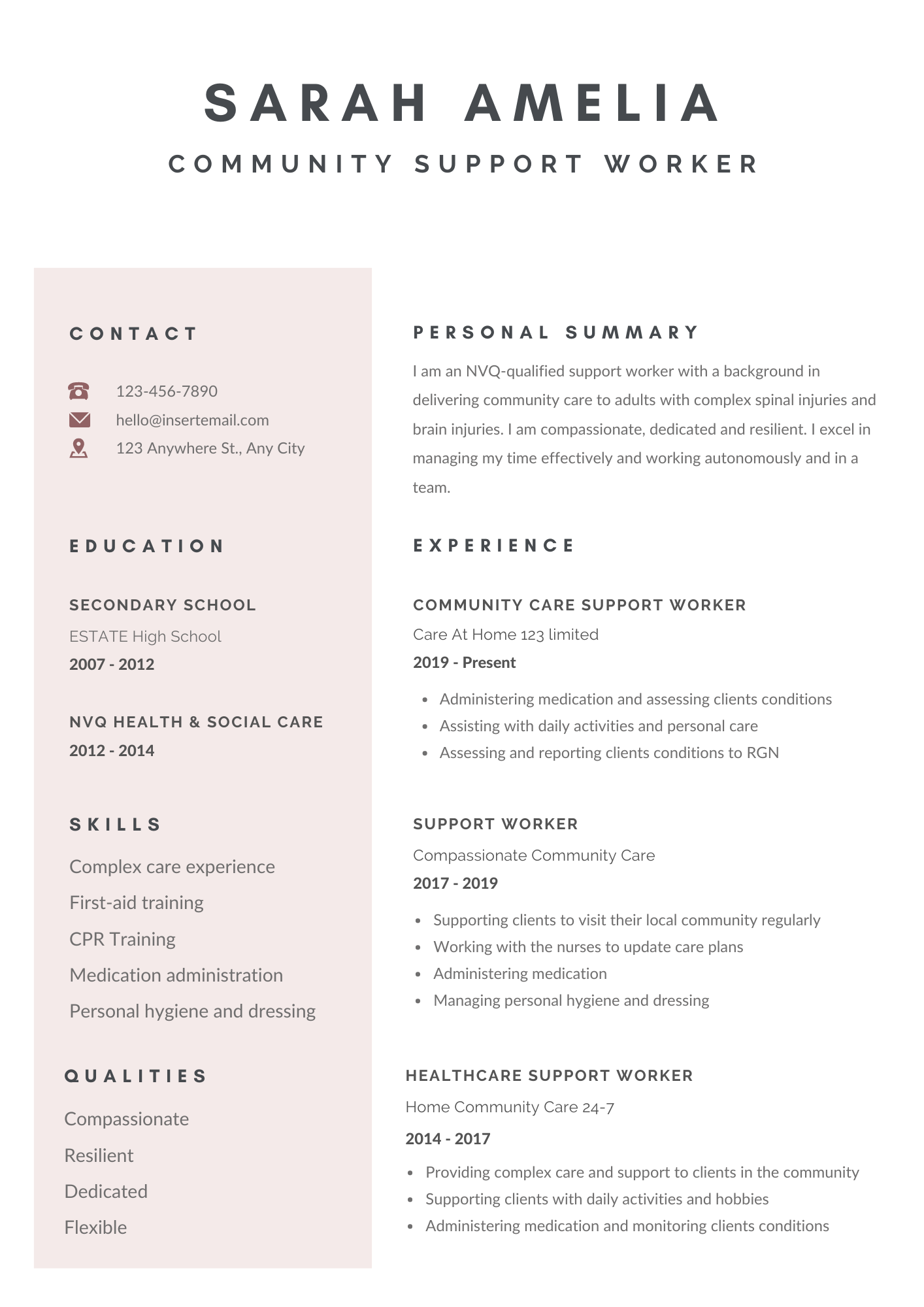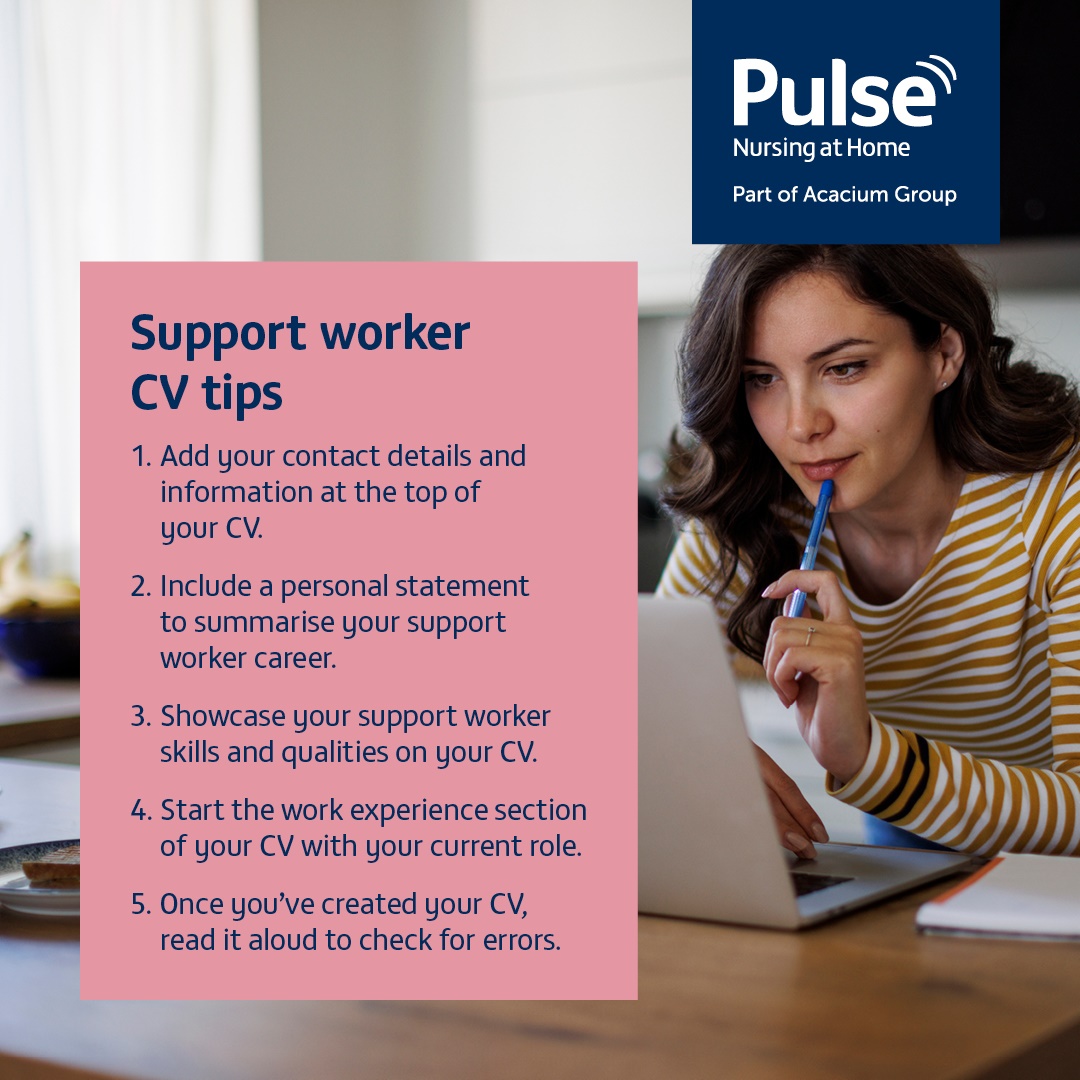 - This post was updated 18th July 2024
- This post was updated 18th July 2024
A well-written and engaging support worker CV can showcase the skills, knowledge and experience you’ve gained from your support worker career and demonstrate to potential employers how you would be the perfect fit for their company.
Understanding the information to include and the ideal format and style for your CV can help you create an eye-catching CV that attracts potential employers and may lead to an invitation for the interview you were hoping for.
In this guide, we will cover the following to help you create the perfect support worker CV:
How to structure and format your support worker CV
The structure and format of your support worker CV is what makes it stand out and provides the reader with all the information and details they’re looking for.
It’s important to remember the reader will initially skim-read your CV, among many others, so formatting your CV in an engaging and professional style is what will grab their attention.
Let’s look at the key elements of a well-structured and formatted support worker CV.
- Select a professional and clear font
- Choose one or a few colours to use on your CV
- Use space and margins effectively
- List your work experience in reverse chronological order
- Use headers and bullet points to display specific information
- Keep your skills and qualities short and concise
1. Select a professional and clear font
The readability of your CV can impact the entire experience for the reader. When choosing a font for your CV, select a clean and simple font that isn’t too detailed and complicated. Here are the top 6 fonts to consider:
- Arial
- Lato
- Calibri
- Verdana
- Proxima Nova
- Roboto
2. Choose one or a few colours to use on your CV
If used correctly, colours can help navigate the reader to specific areas of your CV that you wish to highlight. When choosing colours, keep it to 1 to a few and choose a simple colour pallet. Colours to consider are:
- Black
- Dark blue
- Dark grey
- Purple
- Neutral colours like brown, taupe and grey
3. Use space and margins effectively
Spaces and margins can help to spread out and segment the information on your CV to showcase your support worker career in an engaging and easy-to-read format.
The most popular CV margin size to use is 0.5 inches – 1 inch. Depending on the software you use can determine how you set your margins for your CV.
4. List your work experience in reverse chronological order
Listing your work experience in reverse chronological order makes it easier for potential employers to determine whether your most recent work experience aligns with the experience required for the role you’re applying for.
5. Use headers and bullet points to display specific information
A CV contains lots of valuable information, so displaying it in an easy-to-read format can make it easier for the readers to quickly get the information they need.
Headers can provide a brief overview of the information you’re going to cover before the reader has even begun to read it. Use headers to inform the reader of the different sections of your CV, such as your jobs, your qualifications and achievements.
Bullet points are great for listing the roles and responsibilities of each job in a clear and professional format.
6. Keep your skills and qualities short and concise
As a support worker, you will have gained many skills and qualities throughout your career, so it’s important to showcase them on your CV in a way that the reader can digest this information quickly.
Grouping your skills and qualities and summarising them in bullet points can help a potential employer gain a good understanding of your skillset.
How to create an applicant tracking system optimised CV for potential employers
To help organise CVs and identify ideal candidates, employers may use applicant tracking systems (ATS) to manage CVs.
To increase your chances of your CV being selected by an ATS, it’s important to understand how to write an ‘optimised’ CV that is ATS-friendly and identifies you as a strong candidate for the roles you’re applying for.
What are applicant tracking systems?
An applicant tracking system is software that enables recruiters and employers to track candidates throughout each stage of their recruitment process, from receiving a candidate’s CV to offering them the role.
To make your CV stand out, it’s important to use ATS keywords on your CV.
ATS keywords are specific keywords or short sentences/phrases that match the specific requirements of the job role you’re applying for. The ATS system will look for these keywords on candidates' CVs.
If you have all of the required experience and skills for the role, add these to your CV, as the ATS can identify them and help you get noticed by employers.
What to include in your support worker CV
When writing your support worker CV, you need to include lots of important information about you, your support worker career and experience.
Take a look below to see the different types of information to include in your CV.
Contact details
Including your name and contact details on your CV is essential if you want the person recruiting for the support worker position to call you back. Ensure your name, telephone number, and email address are marked at the top of the page so they can quickly find your details.
As we live in a digital world, there is some debate about including postal addresses on CVs. It is entirely up to you. If you think it would benefit the hirer to know that you are only a short commute away from the role, include these details.
Personal statement
A personal statement sits at the top of your CV. It’s a short overview of your experience to date. After your name, it’s the first thing an employer will learn about you, providing them with a snapshot of your skills, knowledge, and personality.
When writing a personal statement, try to keep it to 150 words. Be short and to the point. It should briefly explain who you are, what you can offer, and your career aims.
Work experience order – starting with your current support worker job
When writing the work experience section of your support worker CV, list your work experience in reverse chronological order, starting with your current or most recent role. Doing so will give the reader the most up-to-date information about you.
If you don’t have much work experience, include any paid part/full-time work, work experience placements, internships, or volunteering. Even at the beginning of your career, you will have transferrable skills that will be valuable to a prospective employer.
Here are the key work history elements to include in the work experience section of your CV:
- The name of the employers
- Your job titles
- The start to end dates you held the positions
- The role and responsibilities of each job
Qualifications and education
If you're starting your career and looking to add more information to your CV, include your qualifications and education.
List any qualifications, the dates you achieved them, and the institutions from which you got them. Like your work history section, list this section in reverse chronological order, starting with your most recent qualifications.
This section complements your career goals, so it may not be necessary to mention every subject and grade you got unless you recently graduated. As you gain more experience, you may want to reduce this to make space for your work history.
For example, if you have an NVQ/SVQ in Health & Social Care or have undertaken any care-related e-learning courses, include them on your CV. It shows a future employer your investment in your support worker career.
If you have other desirable skills, such as the ability to communicate in sign language, include them in your CV, as they could benefit a future employer.
Support worker skills and qualities
Skills and qualities are core elements to include in your CV. As a support worker, you will gain many skills and qualities throughout your career that can help you stand out as an ideal candidate.
Before adding your skills and qualities to your CV, reflect on your career and examples of when you've demonstrated different skills and qualities that would be worthwhile to include.
This section of your CV doesn't need to be huge; just list a few skills and qualities in bullet point format. It provides an overview and showcases you as a support worker.
These snippets build a picture of you as a professional, helping the hiring manager imagine you in the role.
10 CV writing tips to remember
We’ve collated a list of our top 10 support worker CV tips; select from the top 10 writing tips below to learn more.
- When creating or updating your CV, try to keep it a maximum of two pages
- Avoid adding too much personal information that isn’t relevant to your CV
- To save space on your CV, don’t include your reference details
- Get someone else to look at your CV
- To check for grammar or spelling errors, read your CV aloud
- Include skills and qualities on your CV
- Utilise bullet points and headers when formatting your CV
- Highlight your specialisms and experience
- Keep your support worker CV concise and relevant
- Don’t forget to keep updating your CV
1. When creating or updating your CV, try to keep it a maximum of two pages
The length of your CV depends on your support worker career, skills, experience, and achievements.
If you’re new to the care industry and have only worked one to a few jobs, a 1-page CV should be enough for you to showcase your experience, each of the support worker jobs you’ve worked at, and any essential skills you’ve gained along the way.
If you’ve been in your support worker career for some time and have gained lots of experience, a 2-page CV is a good length for you to provide an overview of each of your support worker jobs, your key responsibilities, and any achievements or awards you’ve gained.
2. Avoid adding too much personal information that isn’t relevant to your CV
Your CV's primary purpose is to showcase you as the ideal candidate and highlight your career as a support worker.
Depending on the length of your support worker career and the experience and skills you've gained will help you determine whether to include elements about your education, hobbies, and interests.
As mentioned in the guide, if you're starting your career, you can use other elements to bulk out your CV, like the above examples. However, if you've gained lots of experience working at different companies, focus on highlighting this on your CV to showcase your expertise.
3. To save space on your CV, don’t include your reference details
If you need more space on your CV, don’t include your reference details, as the employer will request them if you are successful in getting the support worker job.
4. Get someone else to look at your CV
Having someone else look at your CV can help to identify errors and mistakes that you’ve missed. It’s also a great opportunity to get feedback on your CV and see if the person recommends adding or changing anything to further improve it and make it stand out against the competition.
5. To check for errors, read your CV aloud
One easy way to identify mistakes is to read your CV aloud. This will help you check for errors, ensure the tone of your CV is professional, and all the essential information is included.
6. Include skills and qualities on your CV
Highlighting your support worker skills and qualities on your CV is an excellent way for the employer to understand you and what type of support worker you are.
Related: 6 important skills and qualities of a good support worker
7. Utilise bullet points and headers when formatting your CV
Bullet points, headers, and subtitles are great additions to your CV to space out information professionally and catch the reader's eye on areas you want them to see, such as your previous roles and responsibilities, key achievements, and skills.
8. Highlight your specialisms and experience
As a support worker, you will have many responsibilities to ensure your patients or clients receive the very best care and support.
Your CV should include your responsibilities and experience for each role you've worked in. This can give the reader a better understanding of your skills and whether you would be a good fit for the company.
Your CV should also show the different care settings you've worked in. Whether you've worked as a community support worker, a private support worker, or a hospital-based support worker, it's important to show this on your CV and describe the different types of experience you've gained throughout your career.
9. Keep your support worker CV concise
Formatting your CV clearly can help the reader quickly understand what type of support worker you are and the skills and qualities you could bring to the role.
It’s important to remember that employers look through CVs every day, so keeping the information on your CV short and to the point allows them to find out what they need.
10. Don’t forget to keep updating your CV
Your CV will become outdated over time as you change jobs, learn new skills, and obtain new qualifications. Set aside time every six months to review it and make updates and amends so you’re always ready to submit your CV for your next support worker job.

Support worker CV example
We’ve created a support worker CV example for you to use as inspiration for your own.

Key takeaways
Now that you’ve read through the complete guide, you’re ready to create a professional and engaging support worker CV. As you build or update your CV, remember these essential tips.

Support worker jobs with Pulse Nursing at Home
Now you’ve got all the tips and guidance you need to create the perfect support worker CV, take a look at our latest support worker jobs in your area or select from the relevant buttons below to learn more about a support worker career with Pulse Nursing at Home.